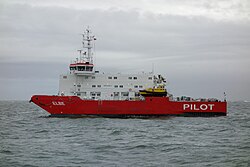Elbe (ship, 2009)
|
||||||||||||||||||
|
||||||||||||||||||
|
||||||||||||||||||
|
||||||||||||||||||
|
||||||||||||||||||
|
||||||||||||||||||
The Elbe is a pilot station ship stationed in the Elbe estuary . Owner of the ship is the Federal Waterways , bereedert it from Lotsbetriebsverein e. V. Branch office Cuxhaven. The ship which is used Lotsenbrüderschaft Elbe.
The Elbe , designed as a SWATH ship, was built under construction number 6484 by the Abeking & Rasmussen ship and yacht yard on the site of the former Sieghold shipyard in Bremerhaven's fishing port . The keel was laid on February 20, 2008, the launch on March 11, 2009. The ship was completed on December 18, 2009.
The ship was christened on March 11, 2010 in Cuxhaven . The godmother was Susanne Ramsauer, the wife of the Federal Minister of Transport, Peter Ramsauer .
The ship replaces the former Elbe , renamed Hanse , which is available as a replacement ship for the new Elbe and also for the Weser, which was put into service in summer 2010 .
Technology and equipment
The Elbe is powered by diesel-electric technology . For electricity generation are four diesel generator sets are available ranging from eight-cylinder - diesel engines from MTU Friedrichshafen , each with 760 kW power are driven. The two traction motors, each with an output of 1260 kW, which each act on a fixed propeller via gearboxes , are from AEM Anhaltisches Elektromotorenwerk Dessau . In addition to the four diesel generators, the ship also has an auxiliary diesel. The motors are housed in the floating bodies and thus separated from the living area.
The ship has a bow thruster with 350 kW power, which is built into the port float.
There is space on board the ship for up to 34 crew members (in single- bed chambers) and 50 pilots (in two-bed chambers ). The ship is designed for a deployment period of two to three weeks. Usually there is a change of staff in Cuxhaven every two weeks. During this time, the Hanse functions as a station ship in the Elbe estuary.
In addition to the regular crew and the pilots, the three-man crews of the transfer boats, who are deployed in shifts, also live on board.
concept
In addition to the Elbe , which functions as a station ship, the concept also includes transfer boats , so-called tenders (named after Cuxhaven's districts Döse , Duhnen and Groden ). The tenders are also designed as SWATH ships and were built by Abeking & Rasmussen. They are 25.65 m long and 13.0 m wide and have a 2.7 m draft. The last Groden built is 14.26 m wide.
The Döse (call sign: DFQA, home port: Cuxhaven) was built in 1998/1999 under construction number 6427. The keel was laid on July 6, 1998, the launch on April 6, 1999. The ship was completed in May 1999.
The Duhnen (call sign: DFLO, home port: Cuxhaven) was built in 1998/1999 under construction number 6428. The keel was laid on August 10, 1998, the launch on July 14, 1999. The ship was completed in August 1999.
The Groden (call sign: DBEX, home port: Cuxhaven) was built in 2011. The ship was completed in late 2011. It is used not only in the Elbe estuary, but also in the German Bight to serve ships that already have to be manned by a pilot there. For this purpose, the ship is equipped with more powerful engines than the other transfer boats.
For ships that cannot be served with the SWATH tenders, two smaller, 8.5 m long transfer boats are available. These are designed as conventional monohulls and, if necessary, are lowered into the water using davits , one on the port and one on the starboard side.
literature
- Kirk R. Williams: New pilot station ship in use. In: SicherheitsProfi. 4/2010, pp. 19–22 ( PDF file; 4.6 MB ).
- Peter Pospiech: MTU sails the SWATH ship “Elbe”. In: Shipping and Technology. 3/2010, ISSN 0936-8396 , pp. 96-97 ( PDF file; 0.9 MB ).
Web links
Individual evidence
- ↑ The new pilot station ship is called “Elbe”. NWZ-Online, March 12, 2010. Accessed on August 31, 2015.
- ↑ Baptism of the second 60m SWATH @ A & R ( Memento from June 2, 2013 in the Internet Archive ), Abeking & Rasmussen, August 2010.
- ↑ a b c Peter Pospiech: MTU's Swath ship “Elbe” is sailing ( page no longer available , search in web archives ) Info: The link was automatically marked as defective. Please check the link according to the instructions and then remove this notice. (PDF; 909 kB) , Shipping and Technology, 3/2010. Retrieved January 20, 2012.
- ↑ Abeking & Rasmussen's pilot tender for WSV , Schiff & Hafen , December 7, 2011. Accessed January 20, 2012.
- ^ Tender Groden has more powerful engines , Cuxhavener Nachrichten , December 2, 2011. Accessed May 5, 2017.
- ↑ Pilot station ships ( Memento from February 25, 2013 in the Internet Archive ), Federal Institute for Hydraulic Engineering


